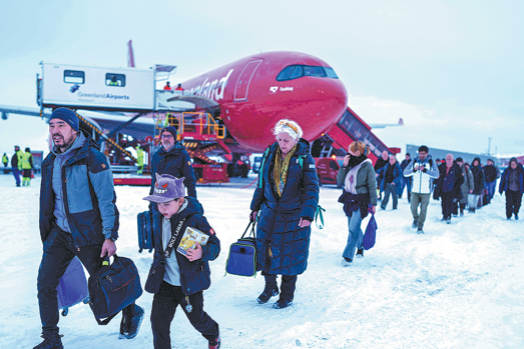Federal Reserve rushes to tame runaway inflation amid skyrocketing prices
By HENG WEILI in New York | China Daily | Updated: 2022-01-04 09:28

With consumer prices in the United States hovering around a 40-year high and the reasons given for inflation are manifold, the Federal Reserve said last month that it would end its pandemic-era Treasury bond purchases in March and prepare for interest rate rises of as much as three-quarters of a percentage point by the end of 2022.
"The economy no longer needs increasing amounts of policy support," said Fed Chair Jerome Powell during a news conference on Dec 15 in which he contrasted the economic doldrums at the onset of the pandemic in 2020 with current rising prices and wages.
The Federal Reserve had originally clung on to hopes that inflation was "transient", though wholesale inflation also soared in November. Supply chain backlog, rising gasoline prices and froth in the real estate market have been listed as reasons that contributed to inflation.
As people emerge from COVID-19 pandemic slowdowns with pent-up demand and soaring personal savings rates that give people more disposable income, the Omicron variant has emerged as a threat that could dampen resurgent economic activity.
Officials projected the Fed's benchmark overnight interest rate would need to rise from its current near-zero level to 0.90 percent by the end of next year. That would kick off a string of rate increases that would see the policy rate climb to 1.6 percent in 2023 and 2.1 percent in 2024-still low by historical levels.
Also missing from the latest Federal Open Market Committee policy statement was any reference to inflation as transitory, with the Fed acknowledging that price increases had exceeded the central bank's 2 percent target "for some time".
The Fed announced it was speeding up its bond-buying tapering, looking to end purchases of Treasurys and mortgage-backed securities, or MBS, by March. Until recently, the Fed had been buying $120 billion of Treasurys and MBS monthly to support economic recovery.
"What we need is another long expansion. That's what it would really take to get back to the kind of labor market that we'd like to see, and to have that happen, we need to make sure that we maintain price stability," Powell said.
"We don't have a strong labor force participation recovery yet, and we may not have it for some time. At the same time, we have to make policy now, and inflation is well above target."
Cecilia Rouse, chair of the Council of Economic Advisers to the president, told Bloomberg reporters in Washington that as "supply chains ease, as people get back to work, as we normalize our economy, the price pressures will start to ease".
Structural shift
Rouse said the economy is experiencing a structural shift.
"This economy has really been through the wringer, and it's still transforming," Rouse said. "People ask me all the time, 'Well, do you think the future of work will look different?' So all of that process is going to be reflected in some of the challenges."
According to a survey by the Federal Reserve Bank of New York, older US citizens and those living in the South and Midwest are more likely to be worried about inflation than younger people in the Northeast and West. The Survey of Consumer Expectations for the month of November also showed another increase in short-term inflation expectations.
In November, the annual inflation rate as measured by the Consumer Price Index jumped to 6.8 percent, a level not seen since 1982.
Also, in the 12 months through November, wholesale prices, known as the Producer Price Index shot up 9.6 percent. That was the largest gain since November 2010 and followed an 8.8 percent increase in October.
"Supply chain pressures should ease in the next few months as holiday shopping lets up and producers have more time to adjust capacity, but the impacts on producer prices and then to consumer prices will not be immediate," said Will Compernolle, a senior economist at FHN Financial in New York.
Social policy
Soaring inflation complicates US President Joe Biden's economic agenda, including a $1.75 trillion social policy and climate bill stalled in Congress.
In a Dec 13 editorial in The Wall Street Journal, it stated that Biden's tax and entitlement plan received what should be "a pair of knockout punches". The trend of surging inflation has been well covered, but the media have largely ignored the second blow-the real cost of the plan if honestly scored.
"We've been telling you for months that the plan's advertised cost of $1.75 trillion over 10 years includes multiple budget gimmicks that disguise the real cost. The Penn Wharton Budget Model has scored the 10-year cost at about $4.6 trillion, but the White House keeps claiming against all evidence that the cost is "zero", the editorial said.
Senator Joe Manchin, a West Virginia Democrat whose vote is needed for Biden's plan to pass, has repeatedly said he will not agree to a package costing above $1.75 trillion.
The White House has argued that the "Build Back Better" bill will help ease inflation over time because its investments will increase productivity and growth, which in turn can lower prices.
"If the president would just pull down Build Back Better until inflation is back to 3 percent, I think the American people would support him," said US Republican Senator John Kennedy on news channel Fox Business on Dec 15.
Mark Zandi, chief economist of Moody's Analytics, said the bill would have marginal impact on inflation in the long run, CNN reported.
"But again, that's pretty small potatoes, because it's very much on the margin and a lot of the programs expire, so they would presumably have no effect later in the decade," he said.
Agencies contributed to this story.
























